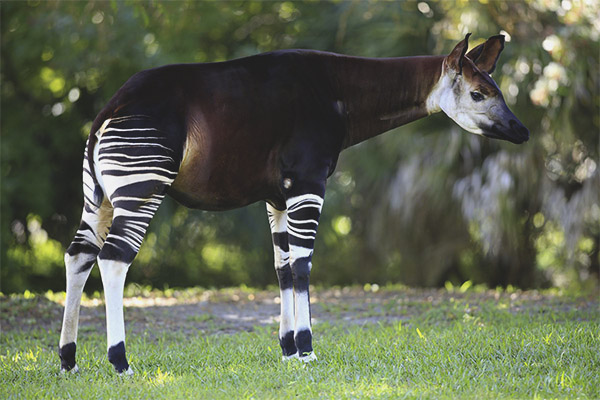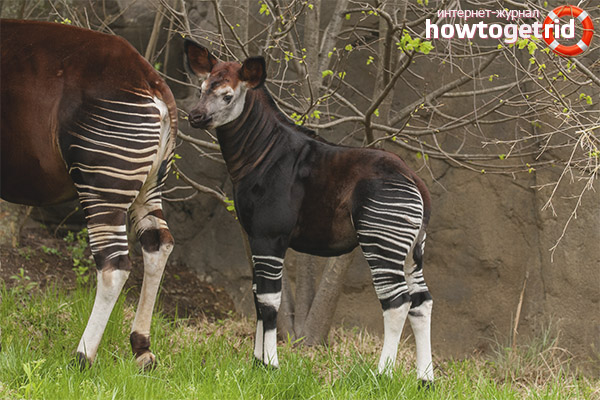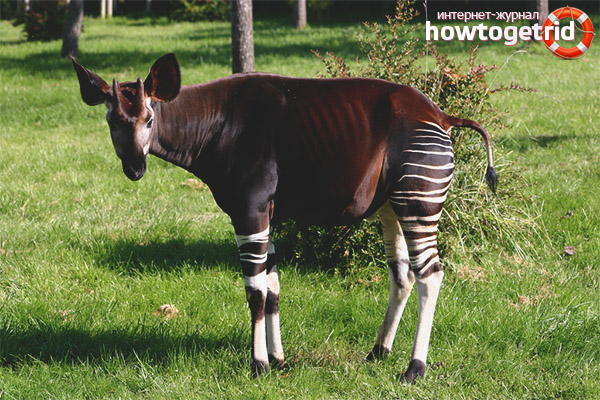The content of the article
Okapi is a very unusual animal that not everyone knows about in our time. The discovery of this species in the animal world has created a furor in the twentieth century. The first information about Okapi was outlined by the famous traveler G. Stanley. In 1890, Stanley wrote and published a report on the animals he met while traveling in the Congo. The evidence for the facts described in the report was found only 10 years later, when another traveler, Johnson, presented a similar description. The information was also confirmed by zoologists, who published a description of a new animal for the public. The original name of the species did not correspond to the existing one, at first the individuals were named “Johnson's horse”.
If we consider Okapi in more detail, then it will be possible to single out that these animals belong to the hoofed. Externally, they are very similar to zebras, however,giraffes are the closest to their relatives. In this regard, there are some similarities in the structure of the body Okapi. They, like giraffes, have rather long legs and an extended neck. However, it is worth noting that the neck is not as long as the giraffe. A similar feature is also a long blue tongue, similar to giraffes. Interestingly, the length of the tongue can reach 35 centimeters. Males to distinguish from females is quite simple, because they have horns on their heads. The color of the okapi is quite dark, the color changes from brown to reddish. On the legs of this species of animals you can see horizontal stripes, very similar to the color of a zebra. The legs of an okapi are usually white, and the bands on them are black or brown.
In size okapi - the animal is quite large. The length of his body can reach two and a half meters, if not take into account the length of the tail. In growth animals usually reach one and a half meters. The length of the Okapi tail is on average 50 centimeters. The weight of the animal is also impressive, it can reach 350 kilograms.
What do okapi eat?
As for food, it is very similar in diet to the food of giraffes. The basis of the menu are the leaves of trees, mushrooms and fruits. Although okapi are very demanding of their diet and always carefully choose products, sometimes they can eat poisonous berries, plants, or even parts of burnt trees, for example, left after a lightning strike. In addition to the listed menu items, these animals also periodically use reddish clay, which is found in various water bodies. This product is for them a source of missing minerals and components.
Breeding
The mating season in the Okapi, like in most animals, begins in the springtime.As a rule, the first thing that can be encountered is the struggle of the males for females. Representatives of the strong half face each other necks. After the male retakes his female, the mating period begins. It lasts not for long, and this time is that rare moment when you can find representatives of different sexes of okapi together. Sometimes it happens to see together with a pair also a small one-year-old cub, to which the male is still positively tuned.
The gestation period in females of this species takes quite a long time. As a rule, the female bears a cub for 15 months. Most often, the female gives birth in the interval between August and October. In the Congo at this time the rainy season traditionally begins. The female chooses a place for childbirth rather carefully, choosing the most remote areas where it will be possible to take shelter for several days. The cub, which is only born, first lies among the vegetation, hiding so that it is not seen. Recognize the presence of the baby can only be due to the low sounds that resemble coughing. Also sometimes the young okapi emit something like a weak whistle or lowing.Even the mother herself has to look for her baby, focusing exclusively on the voice. Okapi babies are born quite large, and even at birth can reach 30 kilograms of weight.
Males feed calf independently within six months after birth. To date, the process of becoming okapi is not reliably described, so it is impossible to say for sure at what point the cub becomes an independent individual. Upon reaching the age of 12 months, the males begin to show small horns. By two years, the individuals reach puberty. In three years Okapi can already be considered an adult. How long an okapi can live in natural conditions is not reliably established by anyone today.
Where can I meet?
Under natural conditions, you can meet Okapi far from everywhere. These animals live mainly in the tropics in the north-eastern part of the Congo. Most often these individuals can be found in the Maiko, Salonga and Virunga reserves.
Locations at an altitude from 500 to 1000 meters above sea level are chosen as the location for the Okapi.The best place for living is to live in areas well overgrown with shrubs, since in such areas it is easiest for them to hide. Extremely rare Okapi can be found in open spaces. As a rule, it is flat terrain near the water.
Interestingly, males and females have separate territories in which they feed. However, these areas may in some cases coincide. In addition, the males can easily let the females into their possession if necessary.
Today okapi are already ranked as rare animals and are listed in the Red Book, however, despite this, their exact number in the Congo has not been reliably established. However, there is a decrease in the number of individuals. This is due primarily to the destruction of forests.
How do okapi live in captivity?
After the discovery of okapi as a new species of animal, it was possible to settle it in a zoo and provide all the conditions necessary for life only in 1919. At the same time the animal lived in captivity only 50 days. The first place that Okapi visited was the Antwerp Zoo.In the future, it was in the same zoo for a long time lived a female Okapi. Her life in captivity was carried out from 1928 to 1943. Perhaps the animal would have lived even longer, but, unfortunately, died with the beginning of the Second World War due to lack of food. Quite difficult for people was given and the process of reproduction okapi in captivity. After the first attempts, the young simply died. The first baby, which people managed to go out and raise, was born only in 1956 in Paris.
The reason for the difficulty of keeping an Okapi in captivity is, above all, their fastidiousness to the conditions of life. For example, sudden changes in temperature, as well as fluctuations in air humidity, are destructive for them. Moreover, it is very reverently Okapi relate to the composition of food.
Despite the existing problems, it is worth noting that today considerable progress has been made in arranging the conditions of Okapi maintenance. At the moment, young individuals adapt much more quickly to life in the aviary. At first, the experts offer the animals only the food that is familiar to them, and also try, if possible, not to bother them at all. The fact is that it is very important to provide calm to the young.In a severe stressful situation, the animal's heart may simply not withstand the load, as a result of which the okapi will die. Only after the animal gets used to contact with people, it is transported to the zoo. It is important that males and females are kept apart from each other. In addition, zoo specialists are instructed to control even the degree of illumination of the enclosures. As a rule, only one bright area is allocated, the rest of the territory is left dark.
Video: Okapia (Okapia johnstoni)














To send